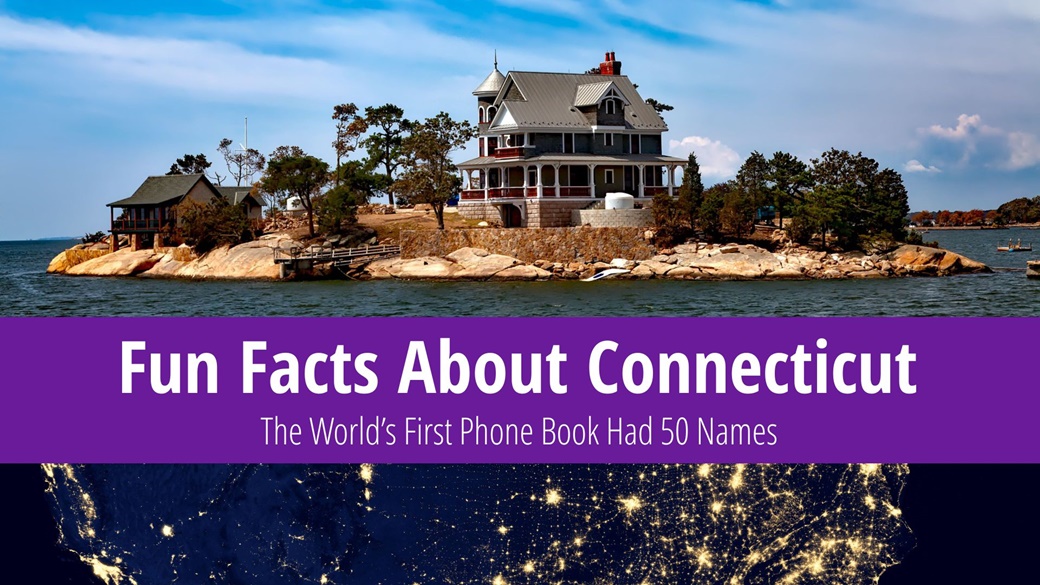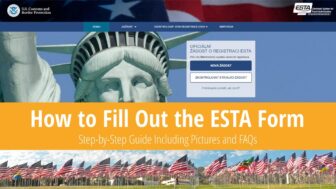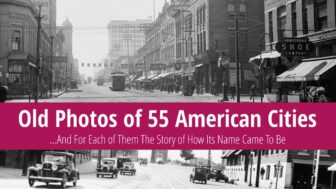In the state of Connecticut in the eastern United States, the world’s first telephone directory was published in 1878. Who published it, and how many phone numbers did it contain? And what was the first legally enforced speed limit, introduced by Connecticut? Read on to discover more fascinating facts about this state and learn which world-famous dish was first served in a restaurant in New Haven.

-
Table of Contents
- First Telephone Exchange in the World Opened in New Haven
- Connecticut Was the First State to Enforce a Speed Limit
- The First Hamburger in the U.S. Was Served in New Haven
- Connecticut Was the First to Issue Permanent License Plates
- The First Cookbook in the U.S. Was Published in Hartford
- The World’s First Payphone Was Installed in Hartford
- Colonists Hid the Royal Charter Inside an Oak Tree
- The World’s First Nuclear Submarine Was Built in Groton
- Connecticut Was the First to Brand Livestock
- Record Temperatures in Connecticut
- Connecticut Was the First State to Have a Constitution
- Gillette Castle Has Hidden Passages
- The First Public Library in the U.S. Was in Connecticut
- A Tree Shaped Like a Door Once Stood in Hamden
- The First Lollipop Machine Was Invented in New Haven
- Color Television Broadcasting Was Developed in Connecticut
- Connecticut Is Home to the Famous PEZ Candy Manufacturer
- Connecticut Has the Oldest Amusement Park in the U.S.
- Connecticut Never Ratified the 18th Amendment
- The First Helicopter Flight in the World Took Place in Connecticut
- The World’s First Telephone Directory Had 50 Names
First Telephone Exchange in the World Opened in New Haven
On January 28, 1878, 21 residents of New Haven became the first subscribers to a commercial telephone network in the world. The city established a telephone exchange that connected all network participants. The subscription fee for the service was $1.50 per month at the time, equivalent to approximately $47 in 2025 prices.
Until then, telephone calls were only possible on private lines between two points. Interestingly, the first telephone operators were mostly teenage boys, but their playful behavior led companies to replace them with women.
-
Connecticut Was the First State to Enforce a Speed Limit
In 1901, Connecticut became the first U.S. state to introduce a law regulating maximum speed limits for motor vehicles. At the time, the speed limit was set at 12 mph in cities and 15 mph on rural roads.
Additionally, drivers were required to slow down or stop whenever they encountered a horse to prevent the animal from getting startled. At that time, horse-drawn carriages still dominated the roads. The speed limit law was later adopted by other U.S. states.
-
The First Hamburger in the U.S. Was Served in New Haven
Louis’ Lunch in New Haven claims to be the first restaurant in the United States to serve a hamburger. In 1900, a customer reportedly requested a quick meal to take away, prompting owner Louis Lassen to prepare ground beef served between two slices of toast.
What started as an improvised meal evolved into what we now know as the hamburger. The restaurant, Louis’ Lunch, still operates today and continues to prepare its hamburgers the same way—grilling the beef on a cast-iron stove and serving it without ketchup, mustard, or additional toppings. The Library of Congress recognizes Louis’ Lunch as the birthplace of the hamburger in the United States.
-
Connecticut Was the First to Issue Permanent License Plates
In 1937, Connecticut became the first U.S. state to issue permanent metal license plates for motor vehicles. Before this, drivers had to obtain new plates every year, which was inefficient and costly.
The introduction of permanent plates simplified vehicle registration, and other states soon adopted the system. Connecticut also helped standardize the design of license plates nationwide.
-
The First Cookbook in the U.S. Was Published in Hartford
In 1796, Amelia Simmons wrote American Cookery in Hartford, making it the first cookbook published in the United States.
The book was revolutionary as it adapted recipes to local ingredients, featuring dishes made with cornmeal, pumpkin pie, and new ways to prepare turkey. Before this, most recipes were based on European cuisine. American Cookery significantly influenced American food culture in the 19th century.
-
The World’s First Payphone Was Installed in Hartford
In 1889, the world’s first coin-operated payphone was installed in Hartford, Connecticut. Invented by William Gray, it revolutionized public communication, allowing people to make calls without owning a telephone.
Payphones quickly spread across the country and became a staple in cities, airports, and businesses.
-
Colonists Hid the Royal Charter Inside an Oak Tree
In 1687, Connecticut colonists hid their royal charter inside a massive white oak tree in Hartford to prevent it from being seized by the English governor-general. This act symbolized the colony’s defiance and desire for independence.
The tree, known as the Charter Oak, stood until 1856 when it fell during a storm. Wood from the tree was used to create chairs and other artifacts, which are now displayed in the State Capitol in Hartford.
-
The World’s First Nuclear Submarine Was Built in Groton
On January 21, 1954, the first operational nuclear-powered submarine, USS Nautilus, was launched in Groton’s Electric Boat shipyard. It revolutionized naval warfare by allowing submarines to stay submerged much longer than diesel-electric models.
Four years later, USS Nautilus made history by becoming the first submarine to travel under the North Pole. Decommissioned in 1980, the submarine is now permanently housed at the Submarine Force Museum in Groton, where visitors can explore its interior.
-
Connecticut Was the First to Brand Livestock
On February 5, 1644, Connecticut passed a law requiring farmers to brand their livestock. All cattle, sheep, and pigs older than six months had to be marked with a burned brand on their ears, and the specific brand design had to be registered in the town records.
The penalty for failing to comply with the law was 34 cents per unmarked animal, with half of the fine going to the town treasury and the other half awarded to the complainant.
The purpose of the law was to prevent livestock theft and ensure that lost animals could be returned to their rightful owners.
-
Record Temperatures in Connecticut
The highest recorded temperature in the state of Connecticut, 106.0 °F, was measured twice—first on August 23, 1916, in Torrington and again on July 15, 1995, in Danbury.
Similarly, the lowest recorded temperature, -32 °F, was also observed on two separate occasions. The first was on February 16, 1943, in Falls Village, and the second on January 22, 1961, in Coventry.
-
Connecticut Was the First State to Have a Constitution
Connecticut is sometimes called the Constitution State because it was the first to adopt a written constitution. In 1639, the document known as the Fundamental Orders of Connecticut was enacted, outlining the framework for the colony’s self-governance and establishing its government.
Most other colonial charters at the time were heavily influenced by the English monarchy. However, Connecticut’s constitution emphasized the principles of government by the people, inspiring future democratic ideals. Some historians consider the Fundamental Orders of Connecticut a precursor to the U.S. Constitution, which was adopted more than a century later.
-
Gillette Castle Has Hidden Passages
Gillette Castle in East Haddam was built between 1914 and 1919 by actor William Gillette, best known for portraying detective Sherlock Holmes.
The castle’s interior features secret passageways, a hand-carved wooden bar with a hidden lock, and strategically placed mirrors designed to observe guests. These unique details reflect William Gillette’s eccentric personality.
-
The First Public Library in the U.S. Was in Connecticut
In 1803, the Scoville Memorial Library opened in Salisbury and is considered the first publicly funded library in the United States. It was funded through money raised by local entrepreneur Richard Smith, who used the funds in London to purchase the first 200 books.
At the time, private libraries requiring membership fees already existed in the U.S., but the Scoville Memorial Library was free and accessible to all residents. It continues to operate today.
-
A Tree Shaped Like a Door Once Stood in Hamden
In Hamden, north of New Haven, there was a white oak tree with a distinctive shape resembling a door. The tree was estimated to be 200 years old, and its unusual form likely resulted from two trees growing together. Known as the Door Tree, it was unfortunately cut down by a vandal in July 2019.
-
The First Lollipop Machine Was Invented in New Haven
George Smith of New Haven, Connecticut, is believed to be the first person in the world to operate a machine that automated lollipop production. This machine could insert sticks into hard candies, making large-scale lollipop production possible. Previously, lollipops were handmade, limiting the number that could be produced at one time. Smith’s innovation helped popularize lollipops in candy stores across the United States.
The word “lollipop” was patented by George Smith in 1931, though he had begun production earlier. He reportedly named it after a racehorse called “Lolly Pop.”
-
Color Television Broadcasting Was Developed in Connecticut
In 1940, engineer Peter Carl Goldmark developed the first color television broadcasting system in the CBS laboratories in Stamford. His invention transformed how people consumed media at the time. The first public demonstration of color television broadcasting took place on August 27, 1940, from a CBS transmitter in New York City.
Although Goldmark’s system was later replaced by other technologies, his research paved the way for the future of color television.
-
Connecticut Is Home to the Famous PEZ Candy Manufacturer
PEZ candies are small, rectangular sweets known for their collectible dispensers. Originally introduced in Austria in the 1920s as peppermint lozenges for adult smokers, PEZ shifted focus to children after entering the U.S. market.
In 1952, PEZ launched its iconic candy dispenser, featuring pop culture characters from Star Wars to Disney. The only PEZ manufacturing plant in the U.S. is located in Orange, Connecticut, and includes a visitor center with a museum, where guests can observe the candy production process. The name “PEZ” comes from the German word “PfeffErminZ,” meaning peppermint, the candy’s original flavor.
-
Connecticut Has the Oldest Amusement Park in the U.S.
Lake Compounce in Bristol opened in 1846 and is recognized as the oldest continuously operating amusement park in the U.S.. One of its main attractions is the Boulder Dash wooden roller coaster, partially built into a mountainside.
Lake Compounce’s history began in 1846 when scientist Samuel Botsford invited the public to witness an electricity experiment. The landowners saw an opportunity and established picnic areas, carousel rides, and boat excursions, laying the foundation for the amusement park.
-
Connecticut Never Ratified the 18th Amendment
The 18th Amendment took effect in 1920, initiating the era of Prohibition in the U.S.. While 46 states ratified the amendment, Connecticut and Rhode Island refused to do so.
Both states had strong brewing and distilling industries, influencing politicians and public opinion against Prohibition. Many viewed the alcohol ban as an infringement on personal freedoms. When the 18th Amendment was repealed in 1933, Connecticut and Rhode Island did not need to implement new measures to legalize alcohol.
-
The First Helicopter Flight in the World Took Place in Connecticut
On September 14, 1939, Igor Sikorsky conducted the world’s first helicopter flight in Stratford, Connecticut. Sikorsky designed and piloted the VS-300, one of the first successful single-rotor helicopters.
This historic flight marked the beginning of modern helicopter aviation and led to revolutionary advancements in transportation. The Sikorsky Aircraft Corporation, based in Stratford, continues to produce helicopters for both military and civilian use. Since November 2015, it has been a subsidiary of Lockheed Martin.
-
The World’s First Telephone Directory Had 50 Names
In February 1878, the New Haven District Telephone Company published the world’s first telephone directory. It contained only 50 names and was released shortly after the establishment of the first commercial telephone exchange in New Haven on January 28, 1878.
Early telephone users in the region included local businesses, government offices, and a few private residences. The original directory was a simple sheet of thick paper listing subscribers. Interestingly, it did not include any telephone numbers. Over time, telephone directories expanded and became common across the United States.

 10 Best Photo Places in the USA
10 Best Photo Places in the USA




Contribute with Your Question or Personal Experience